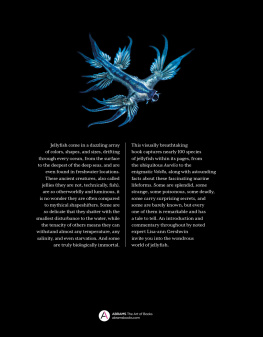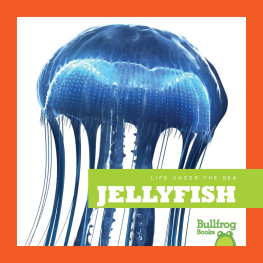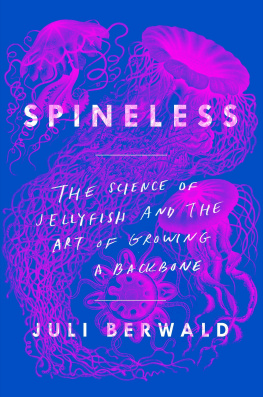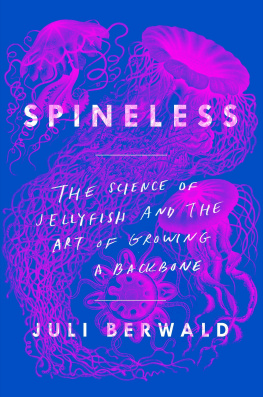Lisa- ann Gershwin is director of the Australian Marine Stinger Advisory Services. She was awarded a Fulbright in 1998 for her studies on jellyfish blooms and evolution, and she has discovered over 150 new species including at least sixteen types of jellyfish that are highly dangerous, as well as a new species of dolphin and has written for numerous scientific and popular publications.
The University of Chicago Press, Chicago 60637
The University of Chicago Press, Ltd., London
2013 by Lisa-ann Gershwin
All rights reserved. Published 2013.
Printed in the United States of America
22 21 20 19 18 17 16 15 14 1 2 3 4 5
ISBN-13: 978-0-226-02010-5 (cloth)
ISBN-13: 978-0-226-02024-2 (e-book)
Library of Congress Cataloging-in-Publication Data
Gershwin, Lisa-ann.
Stung! : on jellyfish blooms and the future of the ocean /Lisa-ann Gershwin ; with a foreword by Sylvia Earle.
pages ; cm
Includes bibliographical references and index.
ISBN 978-0-226-02010-5 (cloth : alk. paper)ISBN 978-0-226-02024-2 (e-book) 1. Jellyfish blooms. 2. JellyfishesEcology. 3. Marine ecology. I. Earle, Sylvia A., 1935 II. Title.
QL377.S4G47 2013
593.5'3-dc23
2012043147
 This paper meets the requirements of ANSI/NISO Z39.481992 (Permanence of Paper).
This paper meets the requirements of ANSI/NISO Z39.481992 (Permanence of Paper).
Stung!
On Jellyfish Blooms and the Future of the Ocean
Lisa-ann Gershwin
With a Foreword by Sylvia Earle
The University of Chicago Press
Chicago and London
To Tom and Tina McGlynn
Thanks can mean a lot... it does here.

For Patrick
And till my ghastly tale is told,
This heart within me burns
Samuel Taylor Coleridge,
The Rime of the Ancient Mariner
[CONTENTS]
by Sylvia Earle
[FOREWORD]
You must see this! Jellyfish! Millions of them. Fifteen year-old Timmy Shriver and his cousin, John F. Kennedy Jr., called from the clear, blue water of Chuuk Lagoon, where they were assisting photographer Al Giddings and me with research for a National Geographic magazine article.
Still on the deck of our dive boat, Al looked over the side and said, Kids! They always exaggerate. A few minutes later, camera finally ready, Al leaped in, took one look and yelled back to me, Hurry and get in here! Jellyfish! There must be millions!
A blizzard of moon jellies seemed to stretch to infinity in the exact place we had dived the day before where we had seen none. The sea appeared to be more jellyfish than seawater, a scene memorialized in a full-page photograph by Giddings in the May 1976 issue of National Geographic. It was my first experience as a witness to phenomena Lisa-ann Gershwin eloquently describes in this book, when certain species of jellyfish or members of another gelatinous group, the comb jellies, have population explosions that seem to magically arise from nowhere. Such events occur naturally, but there are increasing concerns about a distinctly unnatural increase in the number, size, and duration of jellyfish blooms, their causes, and consequences.
During thousands of hours exploring the ocean with scuba and submersibles, and sometimes living under the sea for days or weeks at a time, I have witnessed hundreds of variations on the theme of the ancient, soft-bodied sea creatures collectively known as jellies. I have admired their diaphanous beauty and wondered at how as a group they are at once exquisitely fragile and extraordinarily durable, with a history of survival through hundreds of millions of years of planetary changes. Entire categories of life have come and gone in the past half billion years, but jellies have persisted and prospered. Geologically speaking, humans are newcomers, our recognizable ancestors appearing just a few million years ago, with most of the technological advances underpinning modern society occurring in the past few centuries. The last century, in particular, has been a revolutionary time for both humans and jellies, a relationship that is explored with creative finesse in this volume.
With conversational prose, peppered with reader-friendly terms such as gob-smacking, yep, hullabaloo and jellyfish goo and poo, Gershwin combines her own scholarly research and that of numerous other scientists with concerns that affect everyone, everywhere, in this thought-provoking overview of how the current and future affairs of humankind are linked to that of creatures many think of as a nuisanceif they think of them at all.
Reading this book should inspire heightened respect for these typically translucent creatures, some notable for their sophisticated stinging apparatus, some for their rainbow-colored bands of iridescent cilia, some for their ability to flash, sparkle or glow with their own living lightall, in a sense, living fossils, considering their ancient lineage. They have found and have maintained a place for themselves in the liquid, three-dimensional realm that includes nearly all of the major divisions of animal life known. Carnivores by nature, they are a significant part of the great ocean food web with a dual role as both predator and prey.
I have watched a dozen triggerfish vying for bites of a tattered moon jelly in the Bahamas, and observed a Mola mola ocean sunfish nibbling on a lions mane jelly near Monterey, California. Leatherback sea turtles dive more than a thousand feet to dine on deep-sea jellies, Im told, and I have witnessed one of their cousins, a hawksbill, wrestling with a jellyfish fragment, tearing off and swallowing shimmering chunks near Cocos Island, Costa Rica. But, as Gershwin explains, those who eat jellyfish are no match for those eaten by jellyfish.
In Stung!, the connection between jellyfish blooms and the reduction in certain fish populations is explored, as well as the underlying causes of excep tional jellyfish population explosions that plague coastal resorts and fishing grounds. The apparent increase in size and frequency of such blooms is convincingly linked to human activity, from global warming, overfishing, and habitat destruction to the introduction of fertilizers, toxic chemicals, and plastic trash. Like a detective assembling clues that link one thing to another, Gershwin has gathered extensive data and reviewed research that demonstrate that we should be holding up the mirror to find the underlying causes of problems we attribute to jellies.
In the middle of the twentieth century, it seemed the ocean was too vast, too resilient, for humans to cause any harm. Now we know otherwise. Since the 1960s, 90 percent of many sought-after fish are gone, including sharks, tuna, swordfish, marlin, and many others. Half the coral reefs, mangrove forests, and seagrass meadows have been destroyed or are in a state of sharp decline. Hundreds of dead zones have formed in coastal waters, while phytoplankton has declined globally by as much as 40 percent. Excess carbon dioxide released into the atmosphere is causing the ocean to become more acidic. The increase in jellyfish blooms is one of many signs signaling a sea change.
There are many reasons for despair about the future of the oceanand therefore, of humankind. The ocean is, in effect, our life-support system, driving climate and weather, governing the water cycle, stabilizing temperature, generating most of the oxygen in the atmosphere, taking up much of the carbon dioxide, shaping planetary chemistry. If the ocean is in trouble, so are we.
Armed with unprecedented knowledge, there are ways to resolve some of the thorniest issues and take action that can restore and protect the ocean systems vital to our survival and well-being. Ten percent of the sharks are still in the ocean. Half the coral reefs are in good shape. Most whale species have shown some recovery since commercial killing ended in 1986. Reducing the take of fish, oysters, lobsters, crabs, and other depleted species could help them recover, too. Some nations have begun to establish networks of safe havensmarine reservesaimed at protecting and restoring regions under their jurisdiction and to consider policies for protection of the high seas, a global commons that embraces nearly half of the planet.
Next page











 This paper meets the requirements of ANSI/NISO Z39.481992 (Permanence of Paper).
This paper meets the requirements of ANSI/NISO Z39.481992 (Permanence of Paper).